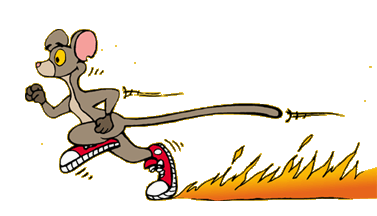
Now, all you wiseacres out there probably said on the shelf, or in a jar - and I guess that could answer the question!
But how does your BODY (or Monomer Mouse's little body) store glucose so that it can get to it fast and easy for quick energy?
 |
We make a polymer called glycogen, which is a lot like starch. It's made out of repeating glucose units put together just like starch, and it has a lot of branches - (more than starch does). Like starch, glycogen curls around and forms a big globby structure. |
Because it's branched and globby, glycogen has ends sticking out all over. Enzymes can attach onto those ends and break the glycogen down fast into glucose units, that can be broken down further (by a bunch of other enzymes) to make ENERGY!
So, where would you expect glycogen to be? Where you need it the most - in your muscles so you can run fast with a burst of energy. (Glycogen is also in your liver.)
Glycogen is really short-term storage. For long-term storage of energy, your body turns that glucose into fat. Fat is a pretty big molecule, but it's not a polymer. Fat can be stored compactly in special cells (called adipose) because it doesn't dissolve in water - it forms droplets in special compartments in adipose cells.
So there you go! That's how your body stores energy. When you eat starch, your body breaks it down into glucose, then makes glycogen for short-term storage. If there's a bunch left over that's not needed, fat is made for long-term storage.